Shamanic Healing Rituals
Tatyana Sem
Russian Museum of Ethnography
During the late nineteenth and early twentieth centuries, healing was the main function of Siberian shamans. They healed many different diseases, such as sterility, protracted childbirth, heart pain, dystrophy, cough, skin diseases, stomach pains, diseases of the throat and eyes, pains in the limbs, and madness. During epidemics they also attempted to cure smallpox and measles, which required much effort.
A single principle was fundamental to shamanic medical treatment: a shaman acted on behalf of spirits and deities, supreme entities more powerful than humans. Disease was associated with spirits' activities. Therefore, shamans had to perform 1) banishment of an evil spirit--the source of disease--from the body of the sick individual, and 2) the return of the soul stolen by evil spirits. To achieve these goals various ritual objects and methods were used.
Helper spirits for hunting and fishing
placed at a Khant sacred place, 1909-1910.
No. 1706-121.
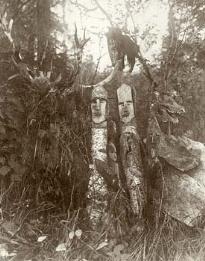
The most complicated and efficient form of healing practice by Siberian shamans included kamlaniye, a shamanic seance that usually continued for several days. Irrespective of the cause of the disease, the structure of the ritual used by most Siberian peoples
(Sel'kups, Yakuts, Evenks, Nenets, Khants, Mansis, Nganasans, and Dolgans) was similar.
The shaman summoned his or her helper spirits using the drum, baton, shaman's
post, shaman's chum, sacred place, and many other ritual objects. Furthermore, the shaman put spirits inside himself (by swallowing and
deep yawning) and treated them to fat, blood of an animal (such as reindeer, dog, or ringed seal), and tobacco. Then the shaman told the victim's fortune on behalf of the spirits and threw the baton in order to learn the cause
of the disease. Alternatively, the shaman sent helper spirits into the body of the sick person for the same purpose, and then the means of "healing" was selected. The spirits were dismissed and a thanksgiving sacrifice was made. During the ritual, the spirit that was to blame for the misfortune was revealed, and the decision was reached as to whom kamlaniye should address: spirits of the upper, the lower, or the middle world.
Sacred tree with gifts for the spirit protector
of the place, Khant, 1888. No. 3954-27.
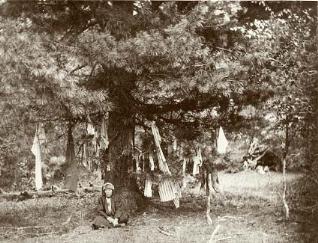
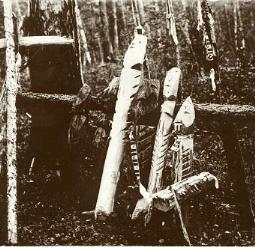
Carved wooden images of helper spirits at a Khant sacred place, No. 305-41.
An important part of shamanic ritual was the preparation of the sacred place, drum, shaman's costume, special curative clothes, and ritual objects. Wooden images that symbolized incarnations of disease spirits were used in curative practices by the Sel'kups, Evenks, and the Dolgans. The spirits were called
upon for mercy by making sacrifices through helper spirits, which could include tribal spirits, spirits of home and hearth, spirits of locality, mountain, earth, water, image of the first shaman, sacred bird (duck or eagle), reindeer or moose, mammoth, or bear. The disease could be moved from a human's body into the substitute's figure. That was usually the end of the shaman's kamlaniye.
Evenk sacred place in central Siberia, early 1900s. No. 6233-5.
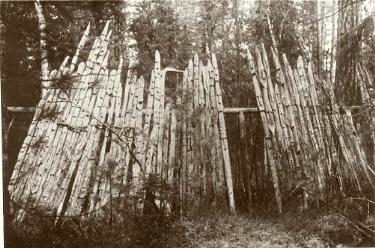
The Sel'kups, Nenets, and Kets depicted the spirit of disease as a worm, stone, blood clot, or lizard. For luring the spirit out of the body of the sick person, shamans transferred the spirit into themselves. Next they made a symbolic piercing. This was practiced to move the spirit of disease into the substitute's figure or into the sacrificial animal. Kamlaniye during which sacrifices were made for supreme heavenly and underworld deities were widespread in Siberian shamanism. The sacrificial animal or object played the role of the intermediary for which the soul of the sick person was exchanged. During kamlaniye over a severely ill person, the Nenets' shaman represented Numu (deity of the Upper World) or Nga (deity of the Lower World). It was through the intermediary that talks about the soul of the sick person took place. Shamans of the Evenks and Yakuts built for that purpose special sacred places symbolizing routes to the heavens. For the Evenks there were images of the shaman's helper spirits, a shamanic tree imitating the world's tree of souls (with nine transverse layers of the Upper World), and a figurine of the substitute of the sick person's soul. The Yakuts had a sacred place represented by a row of trees (three to nine birch and larch trees) connected by a ritual cord of horse's hair with pendants (the symbol of the "route to the heavens") and three poles to which horses are tethered
(serge), imitating the world's tree and three worlds of the universe. Tied to the poles was the animal to be sacrificed (horse or cow) that
was sent to the supreme deity in exchange for a human soul.
Evenk shaman with a collection of shamanic objects,
including images of helper spirits, early 1900s.
No. 5659-120
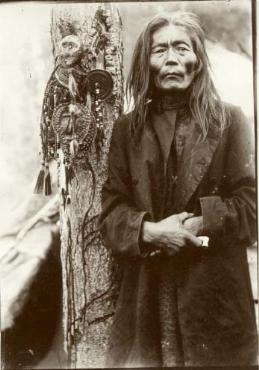
Kamlaniye rites for the purpose of strengthening health occupied a special place in the healing practice of Siberian shamans. During the autumn hunting and fishing feast, Ket shamans collected the soul (ulvei) of
each person in the tribe. The weak souls were fixed in the cell of a fishing net, and in the spring the shamans dismissed them when the group left camp for the season. Ket shamans kept men's souls near themselves in the handle of the drum, whereas family protectors (alel) were in charge of women's souls. Kets explained prolonged illness by the departure of the soul, and performed a special rite of "fixing." They made an arrow and wrapped the end of the shaft in clothes (for men), or a button was wrapped in bands (for women). These arrows were kept with other family protectors. The Evenks maintained the health and life of people by preserving umbilical
cordssymbols of soulsin special "soul keepers"
such as small boxes, nests, or mats.
In addition to kamlaniye, the Sel'kups,
Kets, Chukchis, and Yakuts talked with spirits using ventriloquism and imitation of the voices of helper spirits depicted in the images of mammals, birds, and insects. The purpose of these talks may have been to reveal the location of evil spirits.
For healing the sick, Siberian shamans also used more-simple magical actions,
incantations, and ritual objects, without calling the spirits. Yakut and Evenk shamans touched the sore place with a bunch of twigs. They also used a spoon (for ritual sprinkling over the sick person) and the shaman's baton to
remove evil spirits from the body. Other means of removal included blowing of the disease out of the dwelling (Sel'kups), shaking-off (Yukagirs), banishment by ringing of a bell or by fire (Nenets), and transferring to the dead (Chukchis). Various charms were used for protection, and in special cases two-color cloths were made to deceive the evil spirit. During epidemics, barriers against diseases were put on the roads. During kamlaniye the Evenks and Sel'kups surrounded the shaman's
chum with a special fence, marylya, which
imitated the tribal territory.
Foreword|
Intro|
Hunters|
Shamans|
People|
Healing|
Readings|
Objects





